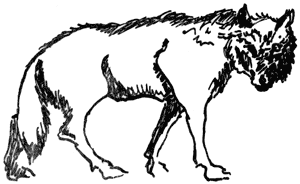|
Volume XIII No. 1 - October, 1947
Pacific Marten
By O. L. Wallis, Ranger-Naturalist
A Pacific Marten or American Sable, Martes caurina caurina
(Merriam), was discovered killed by an auto on the North Entrance
highway, one mile south of the Pumice Desert, on July 31 by Seasonal
Ranger George Swan. Because of its agility and swiftness it is seldom
that one of this beautiful species is reported to be killed by a motor
vehicle.
The specimen was made into a study skin. It is dark yellowish brown
in color with darker tail and feet and with a yellow-orange throat and
chest patch. Although it was a female, the marten was not pregnant nor
was it lactating. The measurements of this female were:
| Total length: | 443 mm |
| Tail length: | 182 mm |
| Hind foot: | 80 mm |
| Ear pinna: | 37 mm |
Pacific martens range in distribution from southern British Columbia
to northern California. They are primarily forest dwellers and are
expert tree climbers. The high value of its fur makes the marten one of
the most valuable furbearers of Oregon, where it is now being protected.
Within the Crater Lake National Park, the marten is protected with all
other forms of wildlife. Park Naturalist George C. Ruhle, who has worked
or made studies in many National Parks, avers that he believes that this
is the best park of all for study and observation of these attractive
members of the Weasel Family.
Wolf! Wolf!
By Dr. G. C. Ruhle, Park Naturalist

Reports frequently come to the office about wolves being seen within
the boundaries of Crater Lake National Park. These are always subject
to skepticism and questioning, so no effort is spared if there is
opportunity to authenticate, confirm, or disprove the observation.
On Friday, January 10, Assistant Superintendent Parker reported that
he had seen a huge timber wolf along the road near the old south
boundary. The description passed on to me averred that his estimate of
the size of the animal included: 125 pounds of weight and 18 inches high
at the shoulder. On Saturday, January 11, I went down to the site of
the observation to investigate. There were tracts of a canine animal
which measured 3-/12 inches long, exclusive of the claw marks; the
distance between tracks was 10-1/2 inches. A very light snow had
fallen, so they could not be described as "fresh" tracks.
It is worthy to mention that I assisted in making a survey for a
park waterline near this site last October. At that time the caretaker
of Crater Lake Lodge, William E. Armstrong, told the naturalist that he
and George Hopper, surveyor and former park engineer, had seen a large
police dog within the park which apparently had gone wild. The location
of this observation was not far to the south from the old boundary. It
is possible that the animals in the two instances are identical.
| 
